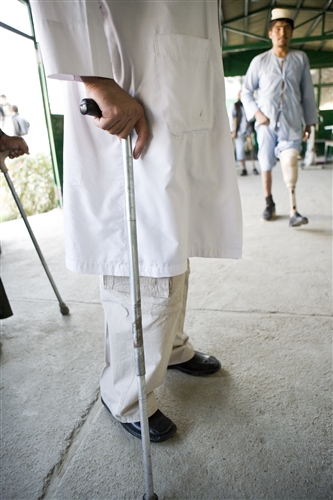Reference :
V-P-AF-E-00890
Date :
22/10/2007
Caption :
Kabul, ICRC limb-fitting centre. Learning to walk again.
Confidentiality level :
public
Publication restrictions :
publication without restrictions
Description :
Tenth anniversary of the Ottawa convention, Media Kit 16.11.07:
The scene at the Ali Abad Orthopaedic Centre in Kabul – the biggest International Committee of the Red Cross (ICRC) rehabilitation facility in the world – is one of almost frenetic industry. Dozens of people in numerous workshops produce everything from leather seats for wheelchairs and stainless steel joints for leg braces, to elbow joints for crutches and custom-made prostheses. Nearby, amputees with newly fitted limbs are learning to walk again, step by painful step. Elsewhere in the centre, paraplegics are receiving physiotherapy.
What makes the centre all the more extraordinary is that the 250 locally employed staff are all disabled. Many are landmine victims, some are victims of car accidents, others are blind, and some have congenital deformities.
"We do practise discrimination here, but we like to call it a positive type of discrimination", smiles Najmuddin Helal, head of the orthopaedic centre and himself a double amputee due to a landmine accident when he was 18 years old. "Hiring disabled people makes sense since they understand the particular problems and needs, and they help to give hope to the patients here."
Of the approximately 40,000 patients registered at the centre since it opened in 1988, some 75 per cent are amputees, and the majority of them are mine victims – although the centre is open to people with all types of physical disability. There is also a big emphasis on social integration programmes, including vocational training and micro-credit schemes, which are as important as physical rehabilitation.
There are many people eager to attest to the
centre's success. Noor Mohamed, who lost a leg in a mine accident 24 years ago when he was 14 years old, now supports his family by making parts for leg braces. Sayed Mohamed, whose right leg was blown off when his car drove over an anti-tank mine more than 20 years ago, set up a vegetable stall with the help of a loan from the ICRC's micro-credit programme. Rohafza Naderi, whose right leg was amputated at the age of 10 after she stepped on a mine by the gate of her school in Kabul, is a physiotherapist at the centre.
"It is so rewarding to help those who most need help, to see someone who was wheeled into the centre be able to walk out by themselves", Rohafza says.
The Kabul centre is one of six ICRC orthopaedic centres across Afghanistan, which together have assisted almost 80,000 disabled Afghans over the past two decades – with limb amputees accounting for approximately half that number.
As one of the most heavily mined countries in the world, Afghanistan has undoubtedly seen measurable progress in recent years. Some 60 per cent of all the land estimated to be contaminated by landmines and explosive remnants of war has now been cleared, according to the UN Mine Action Centre for Afghanistan (UN MACA), with numbers of victims recorded per year falling to 796 in 2006, compared to 1,943 per year five years earlier.
Yet the scale of the problem remains enormous. No-one can be quite sure how many mines remain in the ground, although the UN MACA reports that there are still 4,000 areas suspected to be mine-contaminated, in all but one of the country's 34 provinces. To make matters worse, an unknown amount of explosive remnants of war – including everything from airdropped bombs and mortars to rockets and cluster munitions – also continues to contaminate vast areas of land.
With increasing insecurity and diminishing humanitarian access in many parts of the country, the real number of landmine victims could well be higher than the official data suggests.
Original material :
digital
Resolution :
3328x4992
Orientation :
portrait
Colour/B&W :
colour


